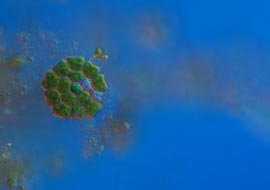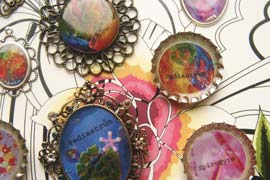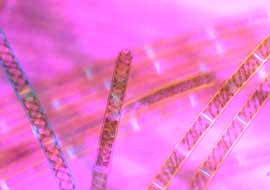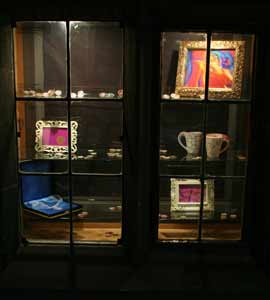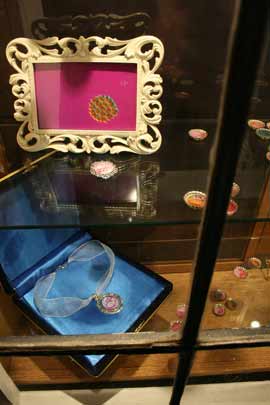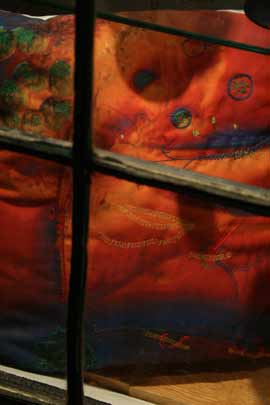Project 6
7th September - 1st October
Corinne Lewis
The Art of Desire
We live in the age of consumerism, where nearly everything is marketed, packaged, commodified and sold to us as something we cannot live without. The contemporary art world is no different. John Mitchell comments that, ‘Modern art is based on profit potential rather than expression of free ideas and communication. Therefore the commodification of art has rendered the message contained within to be obsolete.’1 In other words the value of art is less to do with what the artist believes in but purely as something to be sold. The value of a product is based on the amount of labour taken to produce it and how useful it is considered to be. Art however, places its value on how much it can be exchanged for. The possession of art becomes another means of consumption in which the art is owned for its status and monetary value and not for its intellectual value.
An art piece is only really worth something to a buyer in terms of its monetary value if it is an original. Walter Benjamin in his seminal text ‘The Work of Art in the Age of Mechanical Reproduction’2 argued that the reproduction of an artwork makes the original obsolete, eliminating the ‘aura’ of the one-off object. This allows the artwork to be “owned” by the many rather than the few. Alongside this is the possibility that an artwork can be understood in all the forms it is presented in. For example a photograph of Robert Smithson’s Spiral Jetty, has just as much importance and relevance as the actual land sculpture itself. The same message is achieved even though we are not standing on the shore of the Great Salt Lake in Utah. Therefore what is the artwork, the original or the reproduction? Is one more important than the other or do they have the same value?
Corinne Lewis’ exhibition, The Nature of Desire explores the seemingly limitless human desire to consume unessential ‘luxury’ items and the social and ecological consequences of maintaining such an avaricious attitude. Through her residency in school of Biology at Newcastle University Lewis has been engaging with new technologies in scientific research. Using Microscopy she has photographed live algal specimens, some of which are currently being explored as a possible biofuel, and placing these images onto everyday luxury items such as fabrics, ceramics and jewellery. Lewis aims to look at the relationship between nature and technological advancement and to question the role of consumerism and the object d’art. She creates objects that juxtapose the natural and the man-made and, through the use of technology, documents nature to investigate how one commodifies the other. By exhibiting these works at The Gallery of Wonder the objects become curios and things of wonder and interest.
The Gallery of Wonder takes its name from the Cabinets of Curiosities prevalent during the European Renaissance. Intricate cabinets and even large rooms were filled with vast collections of natural and man made objects intended to provoke a sense of curiosity and wonder in the viewer. Often natural objects were manipulated to make them even more ‘curious’, beautiful shells were augmented with elaborate carving, horns transformed into guilt receptacles. In a similar manner, Lewis employs bright artificial colours to augment scientific photographs and make them aesthetically pleasing and more attractive to the consumer. Lewis investigates this idea of man exploring natural phenomena and manipulating it for their own aesthetic and consumerist ends by subtly invading the realm of consumerism with a sense of the possible ecological price. Resulting in the value of the algae changing from practical to aesthetical and the only way we can value them is by desiring them.
1. Video of a conference paper by John Mitchell with comments by Alan Woods http://video.google.com/videoplay?docid=-8095299740619441345#
2. Walter Benjamin, ‘The Work of Art in the Age of Mechanical Reproduction’, (1935)
Ben Jones
September 2010
Biography
Corinne Lewis is a graduate from the MA in Photography at the University of Sunderland 2008 and has continued to be based in the North East.
Corinne has exhibited at Newcastle University’s Culture Lab as part of Render Exhibit 2009, was artist in residence for Saltwell Park, and has recently completed the Creative Spirit project at the Laing Art Gallery, planning and delivering photographic workshops in conjunction with the refurbishment of The Laing’s Art on Tyneside Gallery. Currently she is working on the Property is Art project with David Goard Lead artist for Gateshead Council and is artist in residence within the school of Biology at Newcastle University, where she is examining the internal structure of live algae specimens through the digital lens based media of Microscopy, working with Dr Gary Caldwell to examine Algal BioFuels – The ‘Marine BioEnergy Initiative”.
Her creative practice is concerned with the relationships between technology and the natural environment. She seeks to explore the interplay between human endeavour and nature, through the examination of forms and structures held within the natural world. Corinne attempts to understand this interplay through scientific, mathematical, and creative conceptual approaches.
